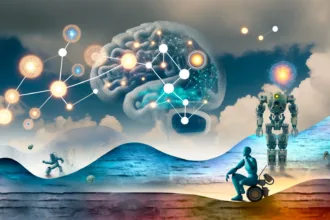Password cracking has long been a keystone of cybersecurity. As passwords protect our most sensitive personal and enterprise data, methods to compromise them can have huge ramifications. This has led to an arms race between increasingly sophisticated password hacking techniques and more robust protection mechanisms.
In recent years, AI has been enlisted on both sides of this battle. AI-driven password guessing programs can now crack passwords far faster than humans. However, AI is also powering new adaptive cyber defenses.
In this guide, we’ll see about can AI crack passwords, its implications, and the future of AI in cybersecurity.
How Passwords Are Stored and Hashed
First, it helps to understand how password security works under the hood. When you create a password during account setup, it isn’t directly stored on the server. Instead, the raw password is run through a cryptographic hash function.
This hash converts the password into a fixed-length string of numbers and letters. For example, the password “Secretsauce” might hash to something like “d8578edf8458ce06fbc5bb76a58c5ca4”.
Hashing enables a few key principles:
- The hash protects the actual password. The original password can’t be derived from the hash.
- The same input password will always produce the same hash output. This allows verifying logins.
- It’s designed to be impossible to reverse the hashing process. This makes deciphering hashes to find passwords infeasible.
When you log in, the password you enter is hashed and checked against the stored hash. If the newly generated hash matches the existing one, the passwords are the same and you’re authenticated.
This hash matching is how passwords are verified without storing them in plain text. But various techniques exist to try and crack hashes back to the original passwords…
How Can AI Crack Passwords
Below are the ways that AI can Crack Passwords.
1. Using Brute Force Attacks to Crack Passwords
A brute force attack simply tries guessing endless password combinations. This exhaustive approach checks hashes against all possible passwords given the parameters.
For example, brute forcing all 8 character lowercase alphabetic passwords would try all 268,435,456 possibilities from aaaaaaaa to zzzzzzzz. While slow, brute force is guaranteed to eventually crack the password.
Brute forcing can be optimized by:
- Trying more likely passwords first based on common patterns
- Using faster hardware like GPUs to compute hashes rapidly
- Targeting weak passwords under 8 characters first
But even optimized, brute force struggles once passwords exceed 10 characters. The search space becomes too large.
While brute force relies on raw computing power, other traditional cracking methods employ a bit more finesse…
2. Employing Dictionary Attacks
Dictionaries full of real passwords and words greatly speed cracking compared to brute force blind guessing. This more targeted approach precomputes the hashes of dictionary words and common passwords.
When attempting to crack password hashes, the first step is matching against the dictionary. For simple or reused passwords, just checking against lists of common terms and passwords will crack a portion of hashes.
Dictionaries are effective because people often create passwords using:
- Names, dates, pet names, addresses
- Dictionary words like “password”
- Repetitive, sequential, or keyboard pattern based passwords
Specialized dictionaries can be tailored to certain demographics or contexts, further optimizing success. While powerful, even large dictionaries can’t cover all of the immense complexity possible in passwords…
3. Leveraging Rainbow Tables
Rainbow tables combine dictionaries and precomputed password hashes for targeted cracking scenarios. Vast databases can cover hash combinations for:
- All passwords up to say, 10 characters
- All lowercase alphabetic passwords up to 14 characters
- Numeric passwords under 9 digits
This allows instantly reversing hashes that fall within predefined sets. Rainbow tables require significant storage for databases but streamline cracking passwords of known bounds.
However, increasingly complex and lengthy passwords diminish the usefulness of rainbow tables. And storing vast databases for all passwords over 10 characters quickly becomes infeasible.
For enhanced password cracking, AI machine learning techniques came to the rescue…
4. Using AI and Machine Learning for Smarter Password Cracking
Modern password cracking leverages AI in two key ways:
Analyzing password data trends – By studying billions of exposed real world passwords and hashes, AI can discern subtle patterns in how people construct passwords. This reveals biases that can help predict new passwords.
Generating and ranking password guesses – AIs can rapidly generate password guesses and rank the most probable options first. This smarter guessing drastically reduces the time to crack passwords.
Rather than blind brute forcing, statistical AI models narrow down the most likely passwords for targeted guessing. Let’s explore some approaches.
5. Training Neural Networks to Guess Passwords
Deep learning neural networks excel at detecting patterns within massive datasets. Researchers are leveraging these capabilities to teach AIs password behaviors.
Key techniques include:
- Analyzing individual passwords – Neural networks ingest huge password corpuses to identify common structures, modifiers, dates, sequences, and personal info used. This reveals tendencies to focus guessing.
- Evaluating password relationships – Comparing multiple leaked passwords from single users helps determine how people modify or reuse passwords across accounts. This enables guessing variants.
- Predicting patterns – Networks can forecast probabilities for the structure and content of new passwords for a given person based on their previous ones.
- Prioritizing guesses – AI ranks potential guesses by likelihood. Educated guesses come before brute force.
- Updating with new data – Continuous retraining on new password leaks improves prediction accuracy over time.
With deep learning applied, password cracking is no longer a brute computational challenge. It’s an intelligent targeting of guess probabilities.
Evaluating the Strengths and Weaknesses of AI Password Cracking
AI-driven password guessing provides unprecedented cracking capabilities. But limitations still remain:
Strengths
- Billions of guesses per second on GPU hardware
- Focused guessing based on real password habits
- Cracks the majority of weak, repetitive passwords quickly
- Computing power continues rapidly advancing
Weaknesses
- Still struggles with lengthy, truly random passwords
- Requires giant sets of real passwords to train on
- Password hash algorithms are also evolving
- Ethical considerations around misuse
While a game changer, AI isn’t foolproof against carefully constructed passwords. Proper password best practices still go a long way.
Length and randomness thwart prediction. Multi-factor authentication adds critical redundancy. And ethical considerations also come into play.
Ethical Considerations Around AI and Password Cracking
As with any powerful technology, AI-driven password cracking carries risks of misuse:
- Cracking for illegal hacking and theft rather than authorized penetration testing.
- Compromising personal privacy through exposure of passwords.
- Training AIs using passwords leaked unethically.
- Automating identity theft and fraud once account access is obtained.
However, principles of ethical AI development help mitigate dangers:
- Carefully vetting how password cracking AIs are deployed.
- Anonymizing training data from password leaks.
- Consulting ethics boards for responsible disclosure procedures.
- Considering safety, transparency, and accountability in AI design.
Responsible researchers aim to illuminate risks without enabling harm. Overall, AI stands to enhance cybersecurity if leveraged carefully.
The Future of AI in Cybersecurity and Password Protection
AI will grow ever more influential in the password cracking arms race. We’ll likely see:
- Open source password guessing AIs requiring increased diligence.
- boBots launching automated customized attacks based on someone’s personal history.
- Passwords being deprecated for stronger multifactor authentication on more sites.
- Fighting fire with fire as AI also bolsters password security and threat detection.
- New blockchain and quantum-resistant cryptography resistant to all classical cracking.
One thing is certain – as AI password guessing improves, reliance on passwords alone will become even more precarious. But AI can also enable more adaptive, context-aware cyber defenses. The future likely holds a synthesis of multiple methods for optimal security.
Conclusion
This blog post provided an in-depth look at AI password cracking capabilities. AI elevates password cracking to new sophistication. But better passwords and increased vigilance in response provide countermeasures. Overall, AI stands to enhance cybersecurity if harnessed responsibly by defenders and ethical hackers alike.
The cat and mouse game of authentication attack and defense will only grow more fascinating. But through vigilance and principles, the white hats can maintain an edge against the black hats.
FAQs: Can AI Crack Passwords
How Do Passwords Get Stored Securely?
Passwords are not stored in plain text. Instead, they are hashed using cryptographic functions, making it virtually impossible to reverse-engineer the original password from the hash.
What is a Brute Force Attack?
A brute force attack is an exhaustive method that tries all possible password combinations to find the correct one. It’s effective but time-consuming, especially for long passwords.
How Does AI Assist in Password Cracking?
AI can analyze large datasets of real-world passwords to discern patterns. It then generates and ranks intelligent guesses, making the password cracking process faster and more efficient.
What Are the Ethical Concerns Around AI in Password Cracking?
Ethical concerns include potential misuse for illegal hacking, compromising personal privacy, and automating identity theft. Responsible use is crucial for ethical AI development.
How is AI Shaping the Future of Cybersecurity?
AI will increasingly influence both sides of cybersecurity, from enhancing password-cracking techniques to bolstering adaptive defenses. Multi-factor authentication and new cryptography methods may become standard.

![Best Mobile Games Your Should Try in 2024 [Trending Now] 2 Best Mobile Games](https://wideaiprompts.com/wp-content/uploads/2024/03/Best-Mobile-Games-330x220.webp)



![Best Mobile Games Your Should Try in 2024 [Trending Now] 9 Best Mobile Games](https://wideaiprompts.com/wp-content/uploads/2024/03/Best-Mobile-Games-150x150.webp)


